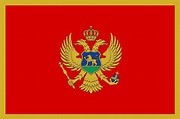
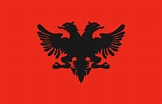
Montenegro
Earlyish morning finds us meandering up a spectacular route through the Dinaric Alps alongside the sparkling waters of the Trebinje river, all the way to the border crossings to Montenegro. These border crossings take a longish while as usual. But eventually I observe the colourful Montenegrin flag with the red background and yellow back to back eagles. We descend the hills the other side. The guide informs us that Montenegro (meaning black mountain) is all rock thus not good for agriculture. In fact, the mountains of the Dinaric Alps running north south through the Balkans (the word ‘Balkan’ means mountains in Turkish) prevented the Ottomans from fully conquering the country. Said mountains later provided the base for guerrilla warfare in WWII by Yugoslav partisans against the Allies.
During its chequered history Montenegro was once part of the Kingdom of Serbia, but the Italians under Mussolini annexed it in 1941, then the Nazis took over in 1943. After the war it became part of Yugoslavia and in 1992 joined Serbia to form the Federal Republic of Yugoslavia, but it became independent from Serbia in 2006 and joined the UN as an independent nation.
Kotor is visible from the mountains as we descend. The coach discharges its passengers for a photo-stop. Looney selfie takers stand on the edge of the cliff overlooking Kotor Bay, intent on getting that perfect shot, oblivious of the perilous drop below them. Kotor Bay, a long winding inlet in the Adriatic Sea, is a haven for ships in bad weather including, at various times, those of the Illyrians, Romans, Slavs, Ottomans, Venetians, Austro-Hungarians, Italians, Germans and, latterly, international cruise line companies. The country is only 2/3 the size of Wales but this, only 100 kilometre long, stunning coastline and mountainous terrain is a magnet for travellers.
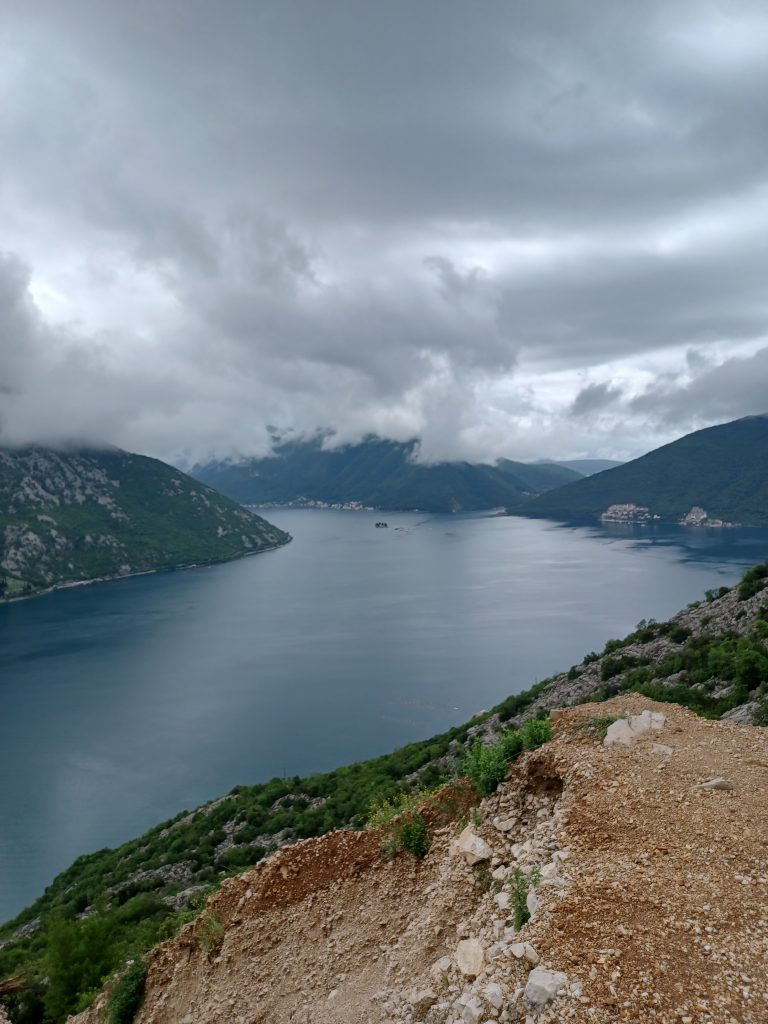
Kotor
So here we are in the old medieval town of Kotor, a UNESCO World Heritage site, where the local guide, a tall good looking chap named George, meets us. Kotor is a more lived in city than Dubrovnik and locals do actually live inside the walls rather than outside. The main squares of Kotor, enclosed by its wall and hung over today by lowering clouds, house monasteries and churches, palaces and mansions. They include the early twentieth century Serbian Orthodox Church of St Nicholas, its façade draped with the white, red and blue Serbian flag and, opposite, the late twelfth century Serbian Orthodox church of St Luke without flag. “There is a relic of St Luke inside”, says George. “The church once housed two altars, one for the Catholics and one for the Orthodox, but now it is Orthodox”. A belfry with three bells sits on top. “This was the only building not destroyed in the earthquakes of 1667 and 1979”, says he (these earthquakes damaged the cathedral in Dubrovnik, as before noted). We peep in.
A large cathedral with two bell towers dedicated to the patron saint, St Tryphon, dominates another square. “This is also the seat of the Roman Catholic diocese of Kotor”, George informs us. “About 10% of Montenegrins are Catholic versus about 90% Orthodox”. Another building of consequence is the old Venetian military barracks. And there are a lot of cats. “There are many stray cats here but all are cared for”, George explains after some keen observant member of our group comments on the various types: a ginger one there, a black one over there, a white one perched on a window sill. They probably arrived on ships, placed aboard to kill the rats and other undesirables. There are several shops with cat souvenirs on offer and even a museum dedicated to them. Cat lovers rejoice.
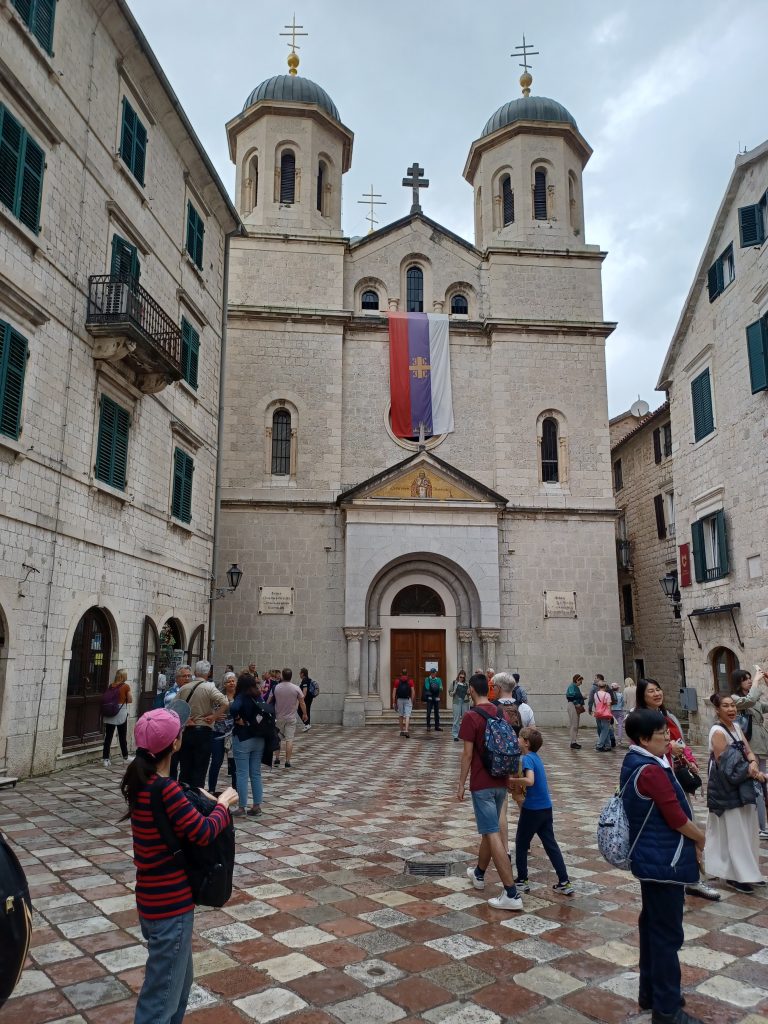
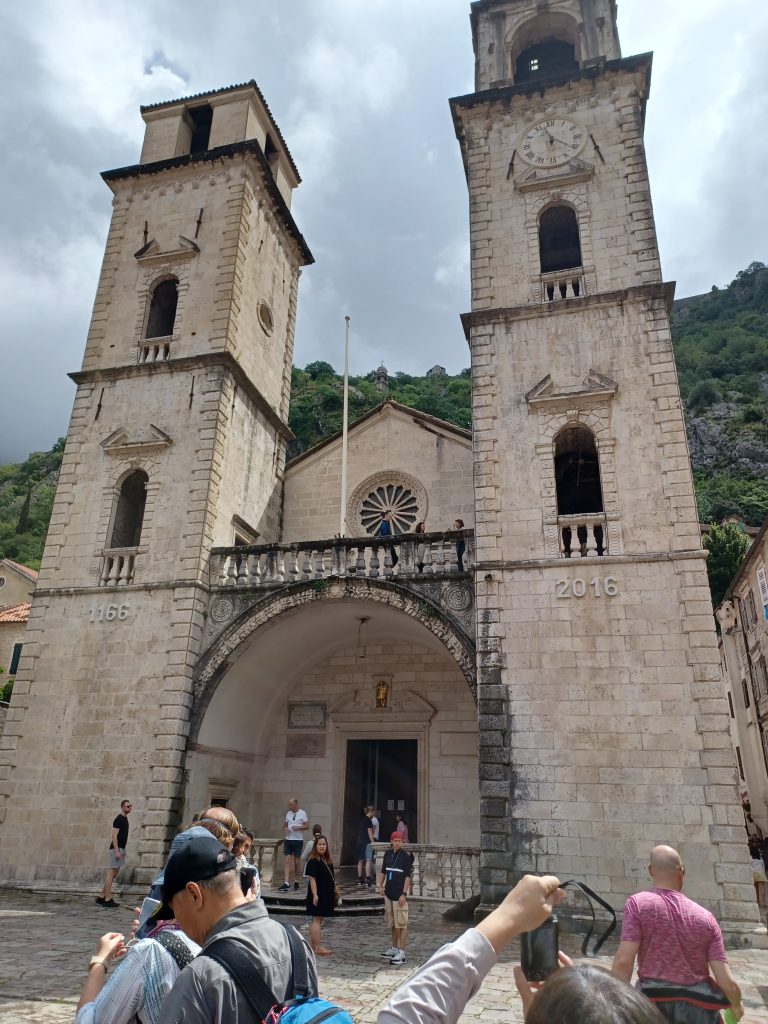
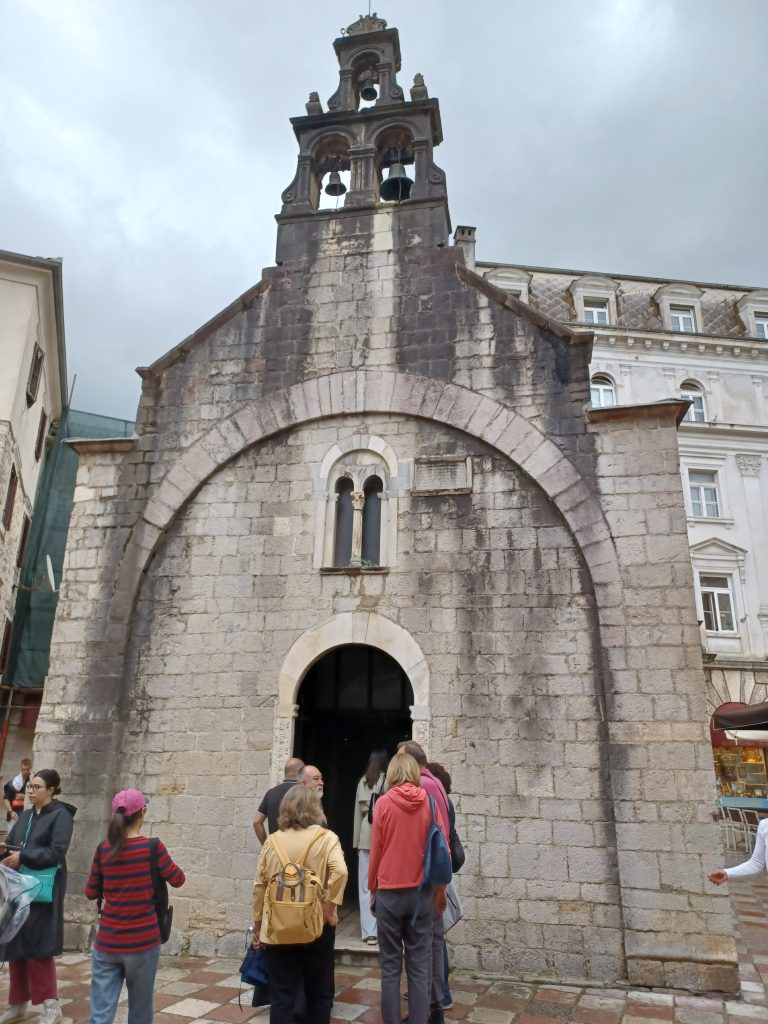
We walk atop the walls, overlooking the bay. A large cruise ship is moored incongruously alongside the small harbour wall, while some rather pretty yachts occupy a small marina. Above and around and about are the mountains with Kotor’s fortifications running up their sides. Half way up the mountain on a steep path is a small Roman Catholic church, that of Our Lady of Remedy, dated 1518, and at the top the large fortress of St John, first built by the Illyrians and rebuilt by the emperor Justinian. No time to saunter slowly up to the church nor St John’s castle as I had opted for a bit of wine tasting. Anyway those lowering clouds release their rain and the palm trees look rather dejected, everyone puts umbrellas up and the paving stones are wet.
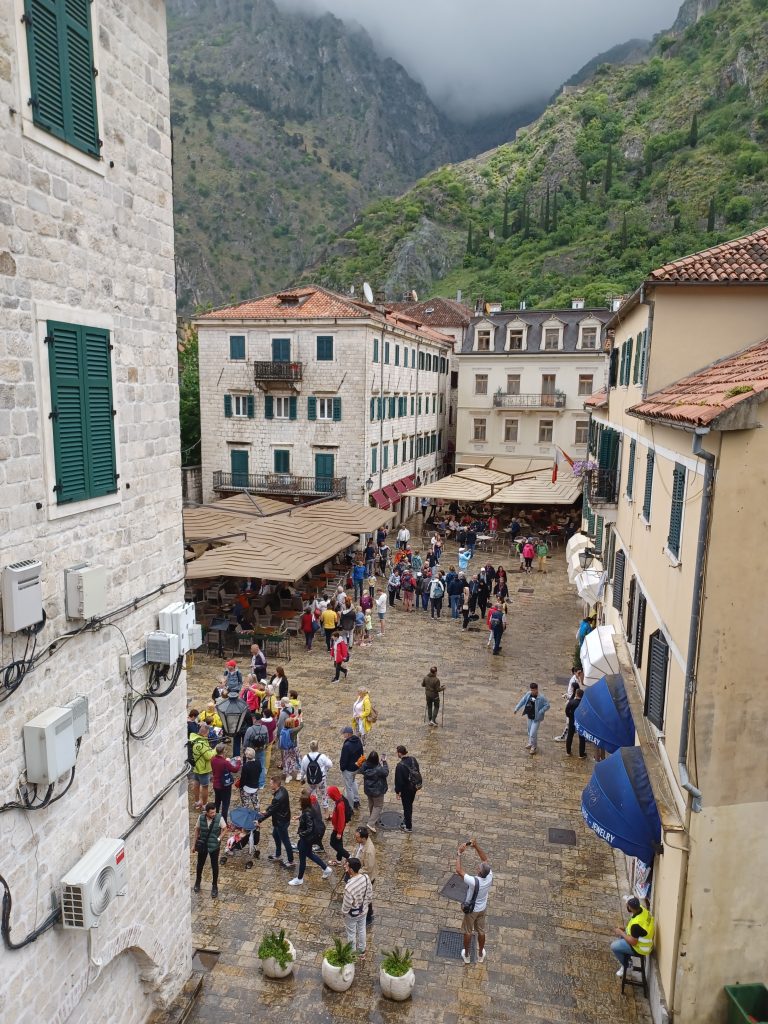
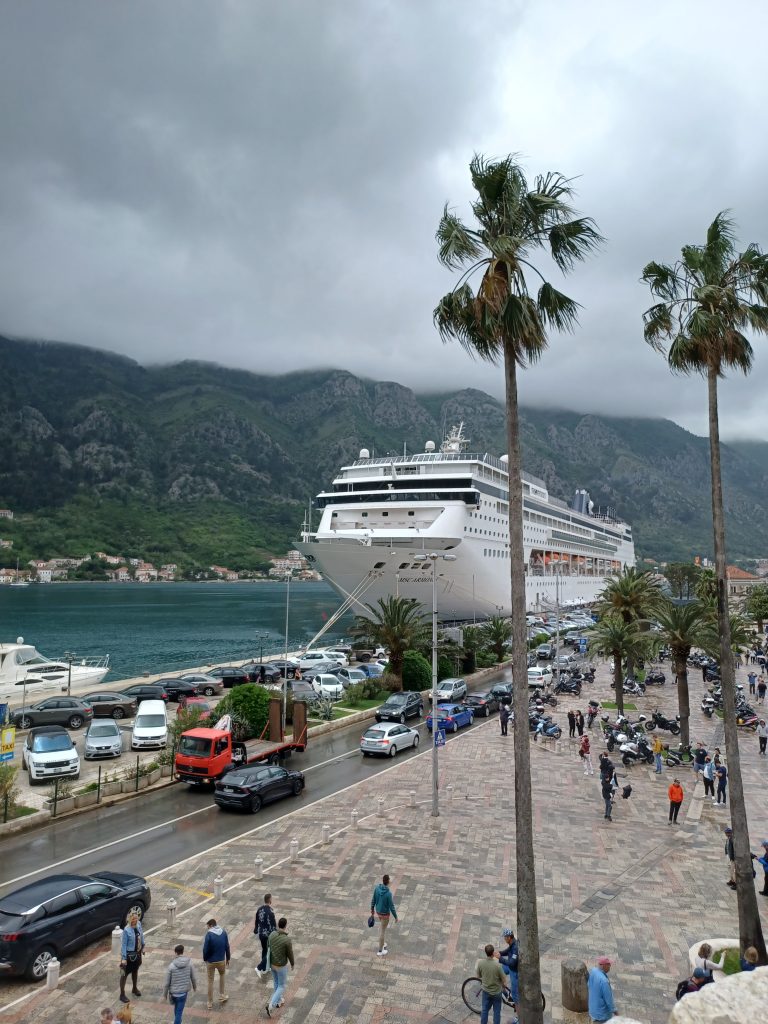
It is now mid-morning and self and two other wine enthusiasts sample three Montenegrin wines. We sit at a table within the precincts of a boutique sort of place selling lacy garments and handbags. Odd venue. The only provender provided to soak up said wines is a bowl of olives. Krstač, a white wine made from local krstač grapes, comes first. Goes down well. Vladika, a ruby red wine from the vranac grape comes next. Savour it slowly. And Stima, another red wine made from the kratosija grape, follows. No spittoons provided. Supposed to drink the lot. We do. Are then offered glasses of rakija, the local brandy. Phew. Not after that. Feel a bit befuddled and need sustenance to sober up.
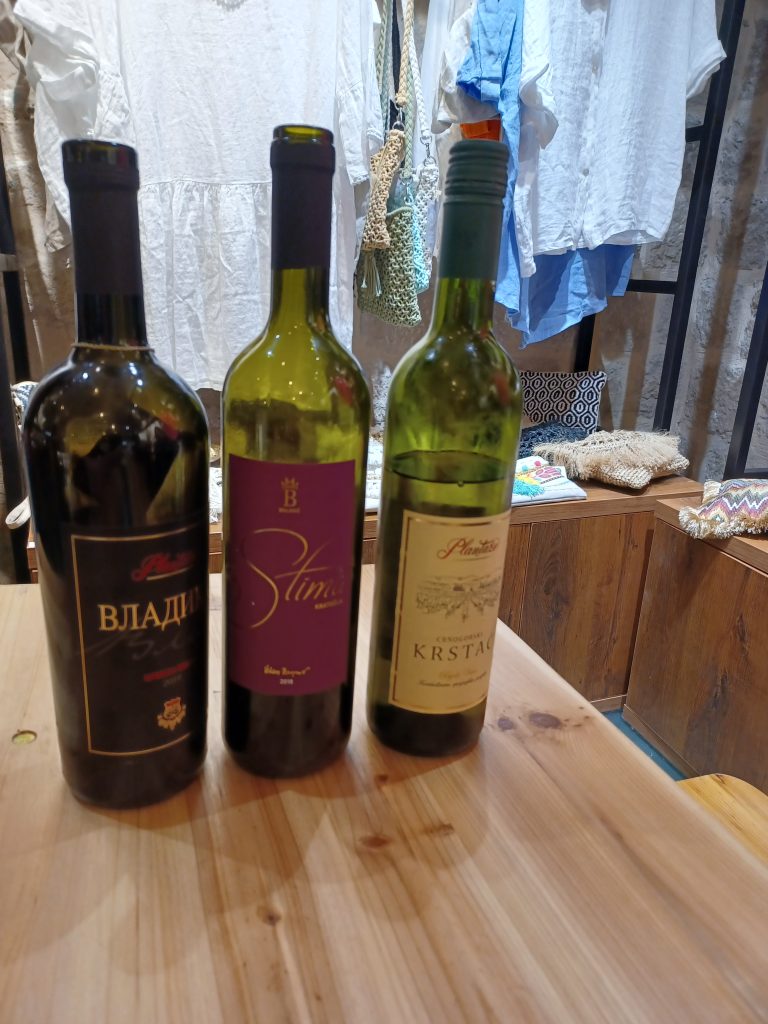
This means I don’t get to see much of Kotor as over an hour of the three hours allocation here is spent imbibing wine. Order a pizza from an establishment on top of the walls, which takes so long to produce that the three of us take it away and eat at the bus-stop.
We board the coach once again. It continues southward past Budva and Bar, which used to be called Antibari as it is located opposite Bari in Italy, to the Albanian border.
Albania
We descend from Montenegro into Albania onto a large plain where many horses and cows graze in the fields. Small cultivated plots with hens running about come and go. Many properties seem to be for sale and the guide tells us that many Albanians are leaving the country for pastures new. Lot of Mercedes cars about. The owners are the mafia of the Balkans apparently. The odd bunker appears in fields. As we enter the town of Shkoder in the north of the country I observe a large fort on a high hill. Hear the call to prayer soon after arrival emanating from one of the many mosques. The hotel room has a bathtub! Bit small but a bathtub nonetheless.
Tirana
One thing I notice when we arrive in Tirana the following day, is that the distinct Albanian flag with its double-headed black eagle on a red background, is flying alongside the EU flag. Yet Albania is not a member of the EU. “Ah” says the local guide, “but it will be. Negotiations are taking place”. Bit premature even so I think to myself. We are told that the double headed black eagle on the flag originated from the Byzantine era when Eastern Orthodoxy split from Western Roman Catholicism, and that “the Albanians have always used this symbol”, and “refer to themselves as sons of eagles”. They claim descent from the ancient Illyrians, who settled the area during the Bronze Age, and they believe that the Albanian language derives from their language. The red background of the flag symbolises the blood lost in wars.
The walking tour begins in Mother Teresa Square, where fascist and communist era architecture are intertwined. These sturdy buildings are now government offices of some sort, one being the offices of the President. Fascist Italy invaded Albania as it did Montenegro, and after the war the communists took over. Enver Hoxha became dictator and, having at first had good relations with Marshall Tito, Stalin of USSR and others, ended up isolating his country from every other country in the region – according to the local guide – “because they were not communist enough for him”. The result was that in 1985, after his death, the country was economically depressed and undeveloped compared to its neighbours. “Hoxha had 175,000 bunkers built to protect the population from the enemy”, we are told. One of these is now a museum in the centre of Tirana, which has 24 underground rooms.
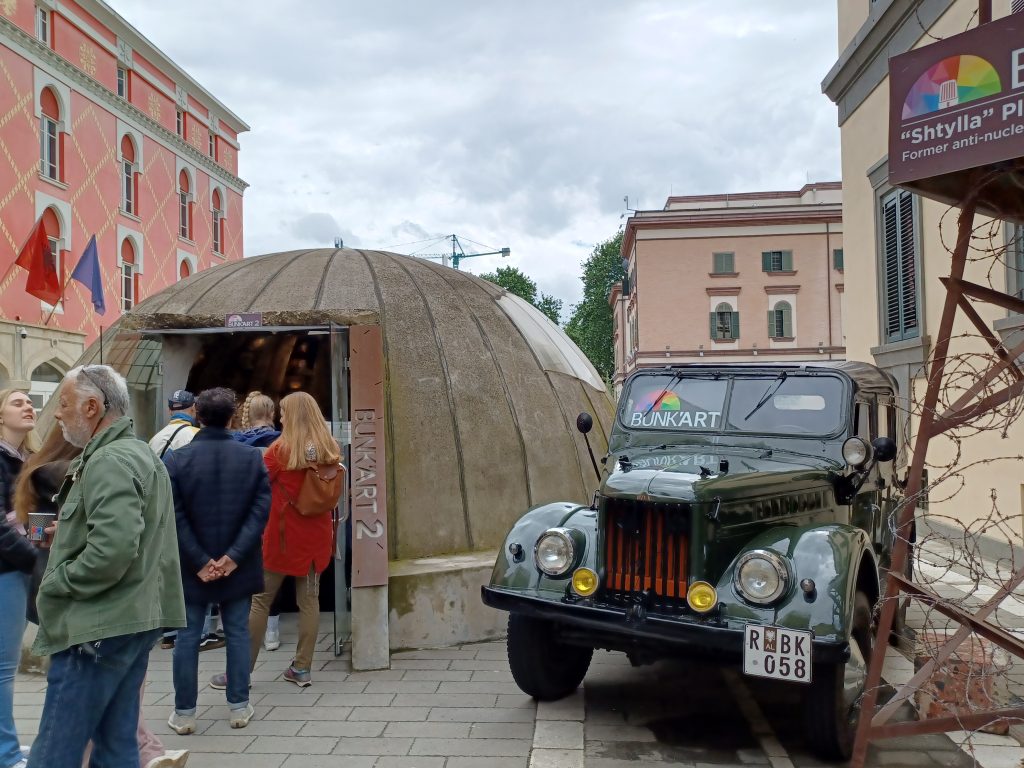
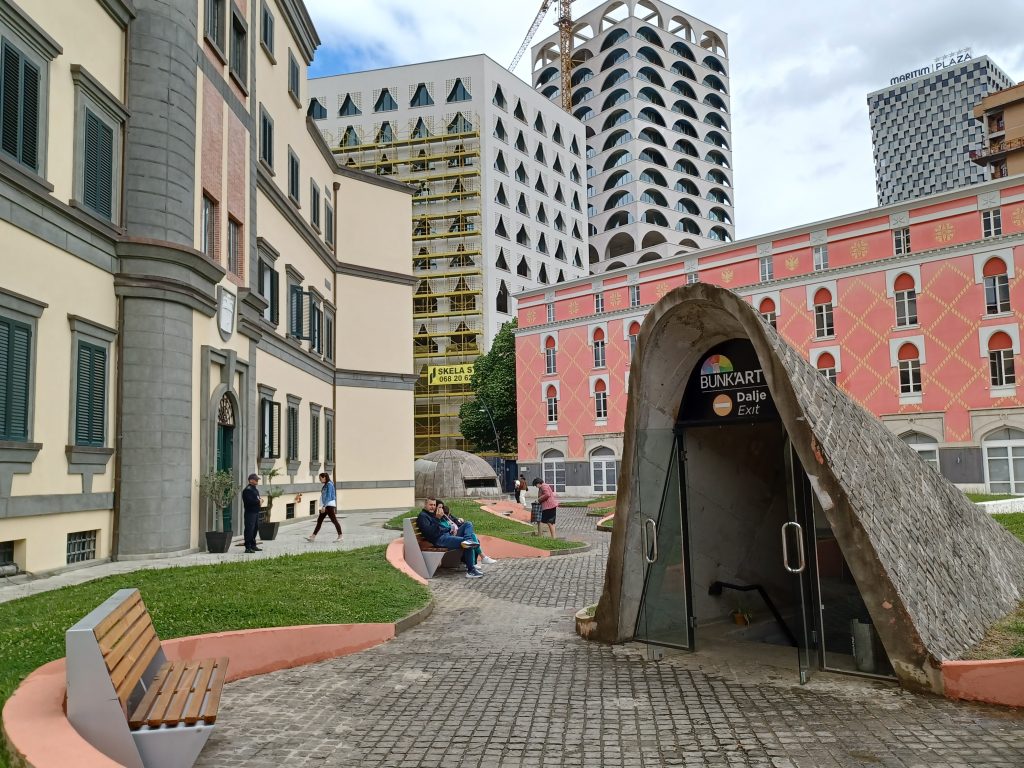
Many of these bunkers have been abandoned now, or used as storage for fodder, or destroyed as new buildings have gone up in their place in the now modern capital.
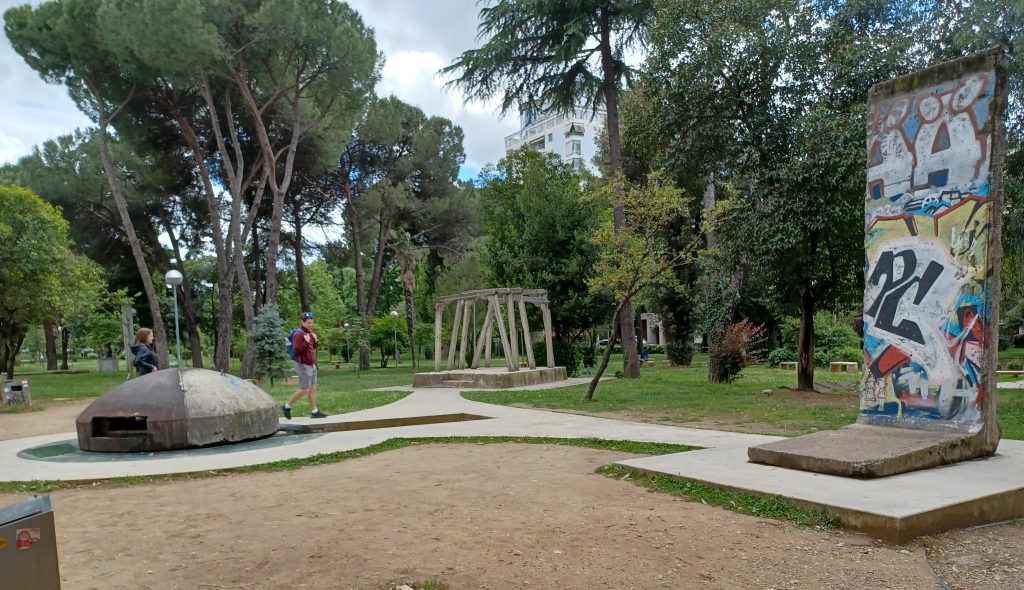
We pass Communist Corner where a bunker sits next to a piece of the Berlin Wall, given to the city by the government of Berlin, along with some concrete girders taken from the Spaç prison where political prisoners were sent for hard labour in the mines.
This part of the city was closed to the public during the Hoxha era, the guide informs us. The area is full of gaily coloured buildings now: reds and yellows, greens and blues, such as the football stadium of red and greyish glass. And the city has many wide boulevards lined with trees. In 1967, we are told, Hoxha declared Albania an atheist state, persecuting both Christians and Muslims, and its people were not allowed to worship. Some churches and mosques were destroyed. Today, out of the current population of 1.2 million about 70% are Muslims, about half of whom are Sufis (whirling Dervishes), about 20% Orthodox and 10% Roman Catholic. “Albania was a secular state for a long time so many people grew up without a religion and adopted one after Hoxha’s death”, explains the guide. Interesting. Because of this, she continues, “prayer and worship are not as regular here as in other places”. We view the new Roman Catholic Cathedral built in 2000. It has modern stained glass windows and a statue of Mother Teresa outside. Although born in Skopje, North Macedonia, Mother Teresa, the guide proclaims, was an ethnic Albanian.
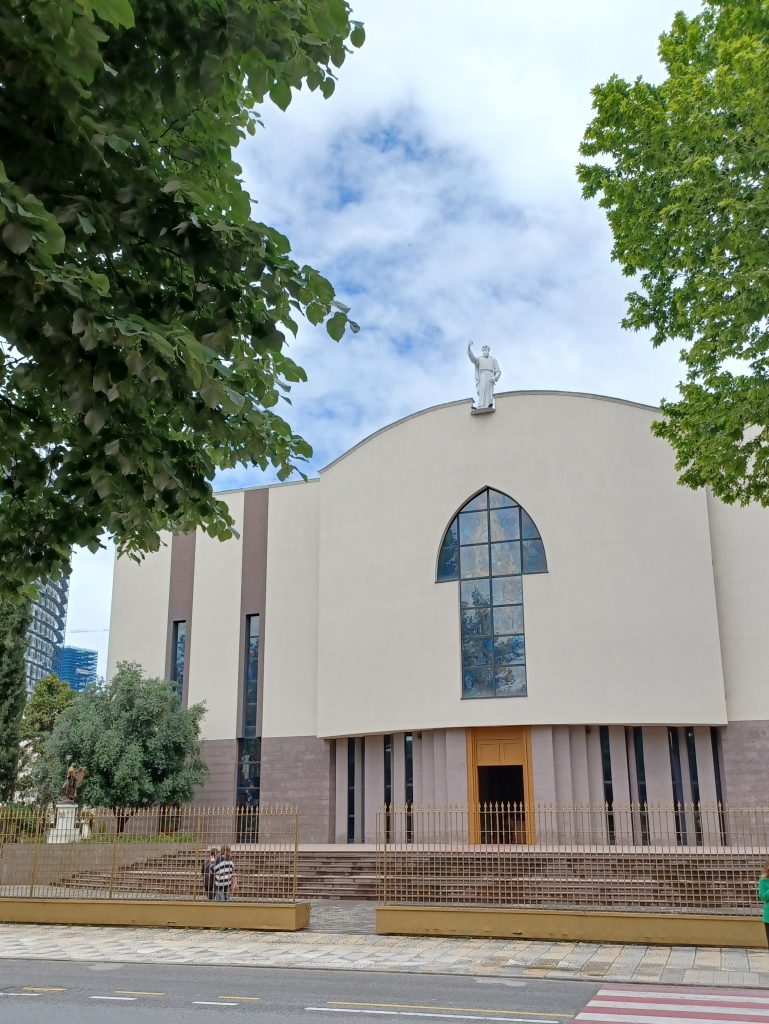
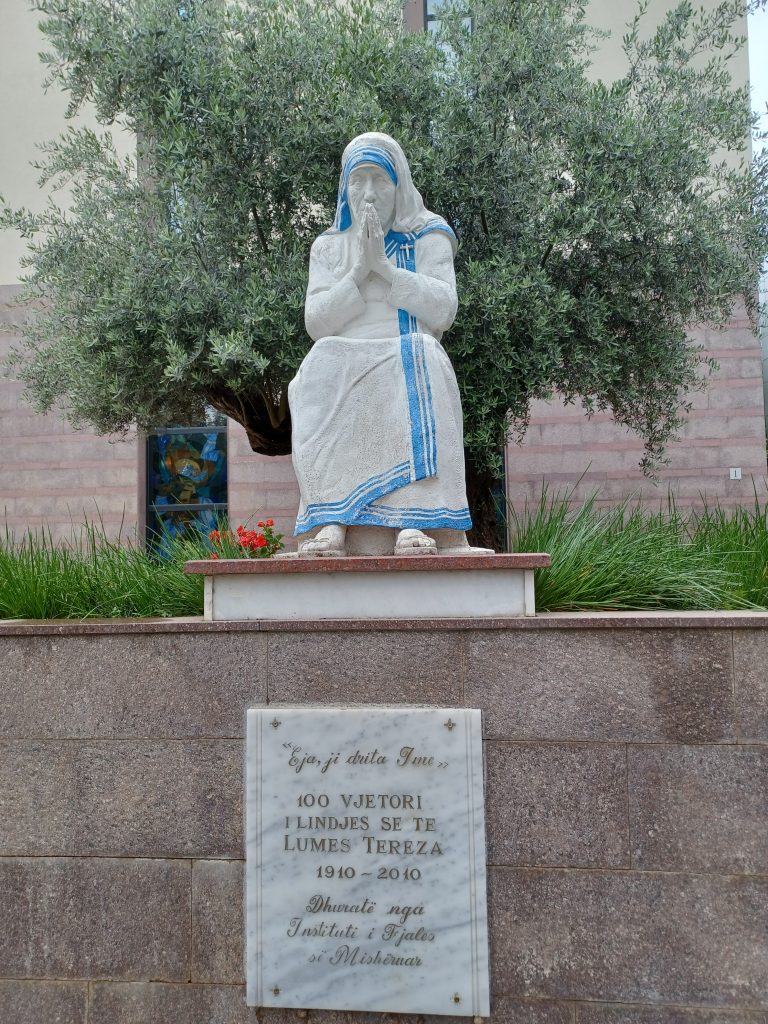
In 1988, Hoxha’s daughter and son-in-law built a pyramid – imitating that of the pharaohs presumably ‒ dedicated to him called the Enver Hoxha Museum in the centre of Tirana. “When communism collapsed, some people wanted to destroy the pyramid”, because, our guide explains “they saw it as a symbol of a brutal regime”. Others saw it as part of Albania’s history. Anyway, it has survived and has been variously repurposed as a conference centre, a NATO base during the war with Kosovo and, more recently, as a technology centre.
Stairs have since been built up the sides of the pyramid to the apex. Quite a climb up the glittering limestone white steps. I get there and look down through the glass cap on top and over the various hued high rise buildings and mosques of the town. Inside the pyramid there are brightly coloured cube shaped studios where young people work in creative technologies. I wander around inside. Bit too cold and concrete for my taste. The edifice has been renamed the Pyramid of Tirana. Placed in front of it is the Peace Bell, made from thousands of melted down bullet cases, apparently. And near the Peace Bell is a bust of Pope Francis, erected to commemorate the visit of the Pontiff in 2014 and in defiance of the ideology of the former dictator.
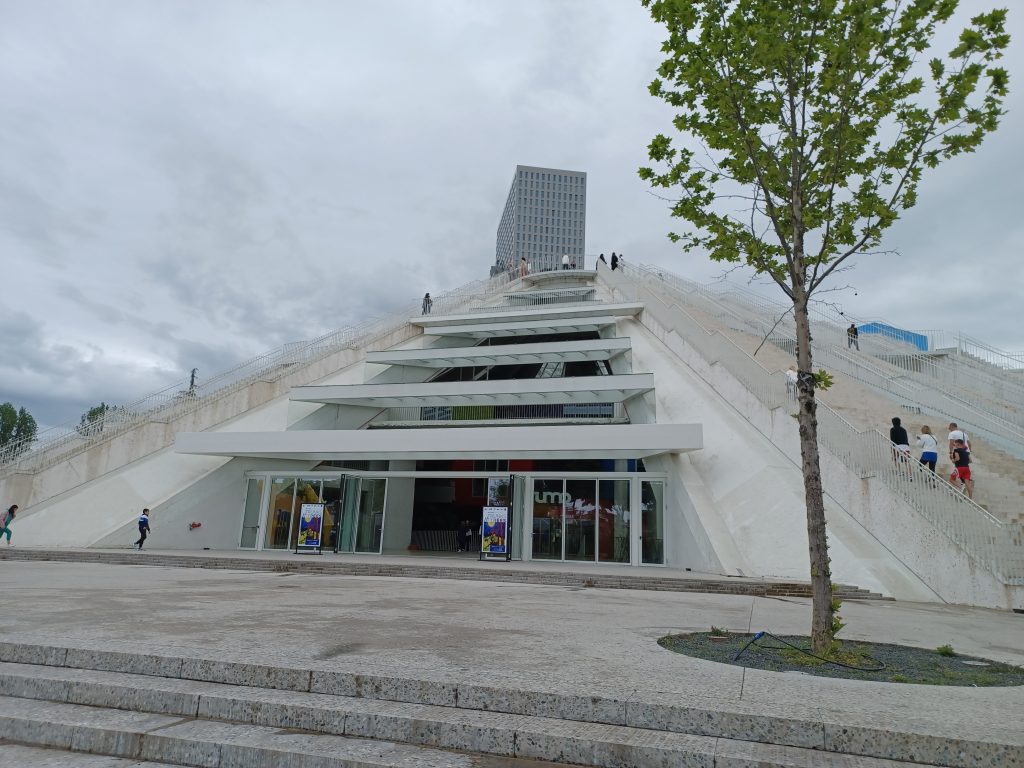
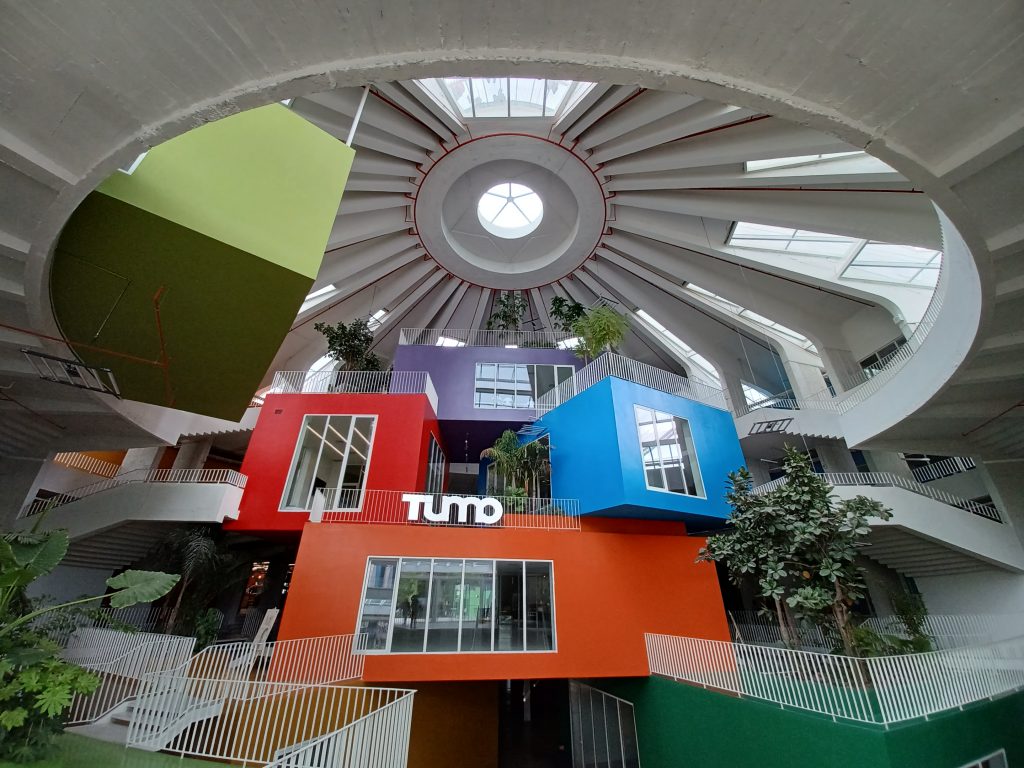
Thence to the 20 feet high walls of old Tirana Castle, the centre of town. We pass through the entrance. According to the information provided, this castle may have been built by the Byzantine Emperor, Justinian. It was demolished by the Ottomans in 1832, leaving some fragments of walls and a bit of the old bailey behind, now intermingled with modern day structures. Inside the castle walls is a lively area with the ‘old bazaar’, shops and restaurants. Some of us purchase baklava, that sticky syrupy nutty filo pastry. Scrumptious.
The area then opens out onto the vast Skanderbeg Square. Skanderbeg is Albania’s national hero, whose impressive equestrian statue is dwarfed by a Big Wheel, painted white, which is not rotating. “Skanderbeg fought for the freedom of Albania against the Ottomans”, our guide informs us. He was successful while he lived, until 1468, but some years after his death the Ottomans took over the country, which they ruled until 1912.
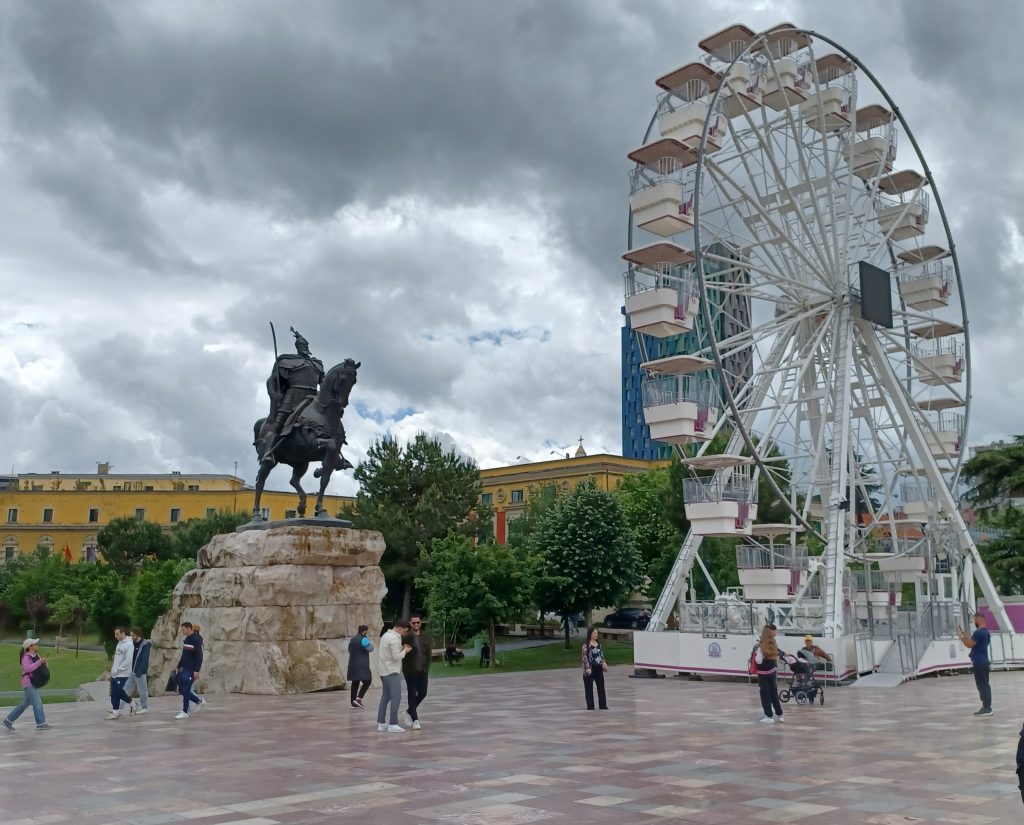
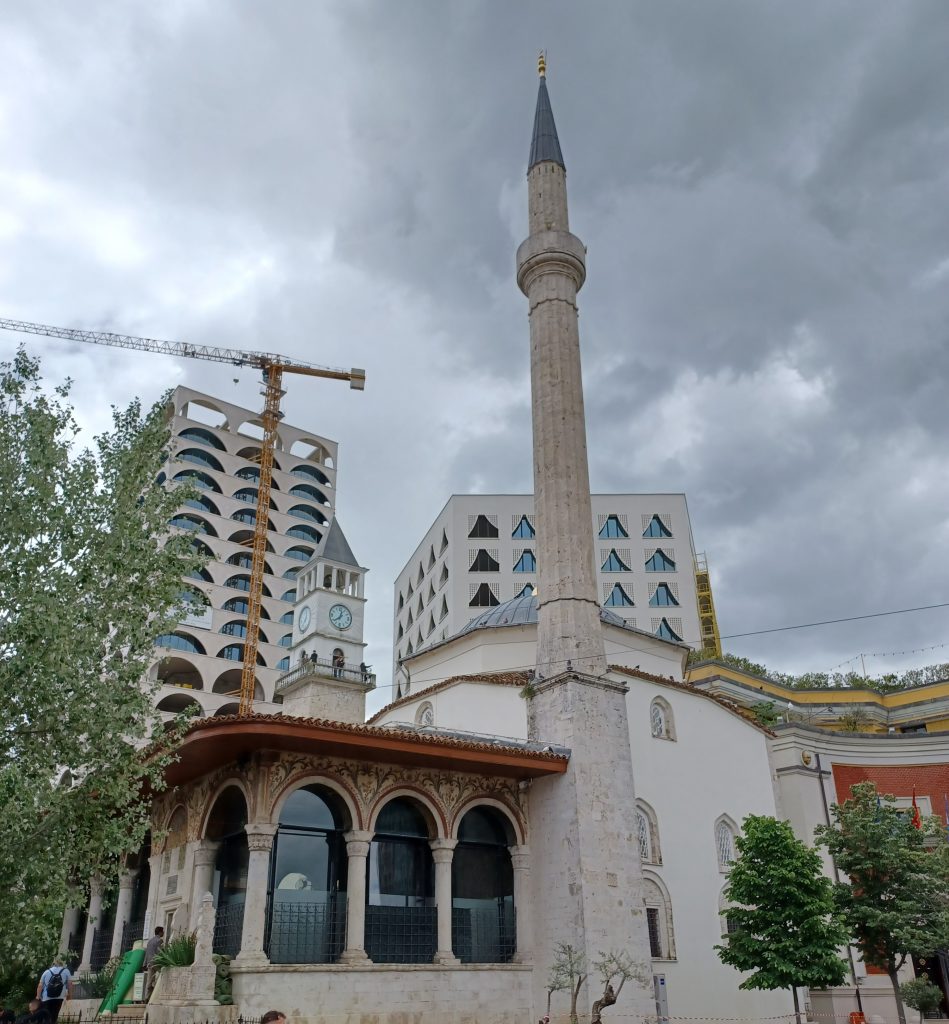
On one side of Skanderbeg Square is the gorgeous Et’hem Bey Mosque, built in the late 18th century, which somehow evaded destruction by Hoxha. “The Mosque was closed until 1991”, we are told. “Then, in January that year, 10,000 Muslims entered it waving flags in defiance of the authorities!” This event signified the beginning of religious freedom in Albania. Adjacent to the Mosque is a clock tower, also built by Et’hem Bey in around 1830. These two structures are the oldest in Tirana.
Heading across Skanderbeg Square we come to the National History Museum. The building has a rectangular mosaic across the top of the façade representing early Illyrian warriors with their bows and arrows, on the left; peasants and partisans under the Albanian flag, centre, and soldiers with their modern rifles and ammunition on the right. On another side of the square stands the very tall yellow Continental Hotel, in front of which is the much smaller National Hotel, whose rooms were bugged in the good old days of communism.
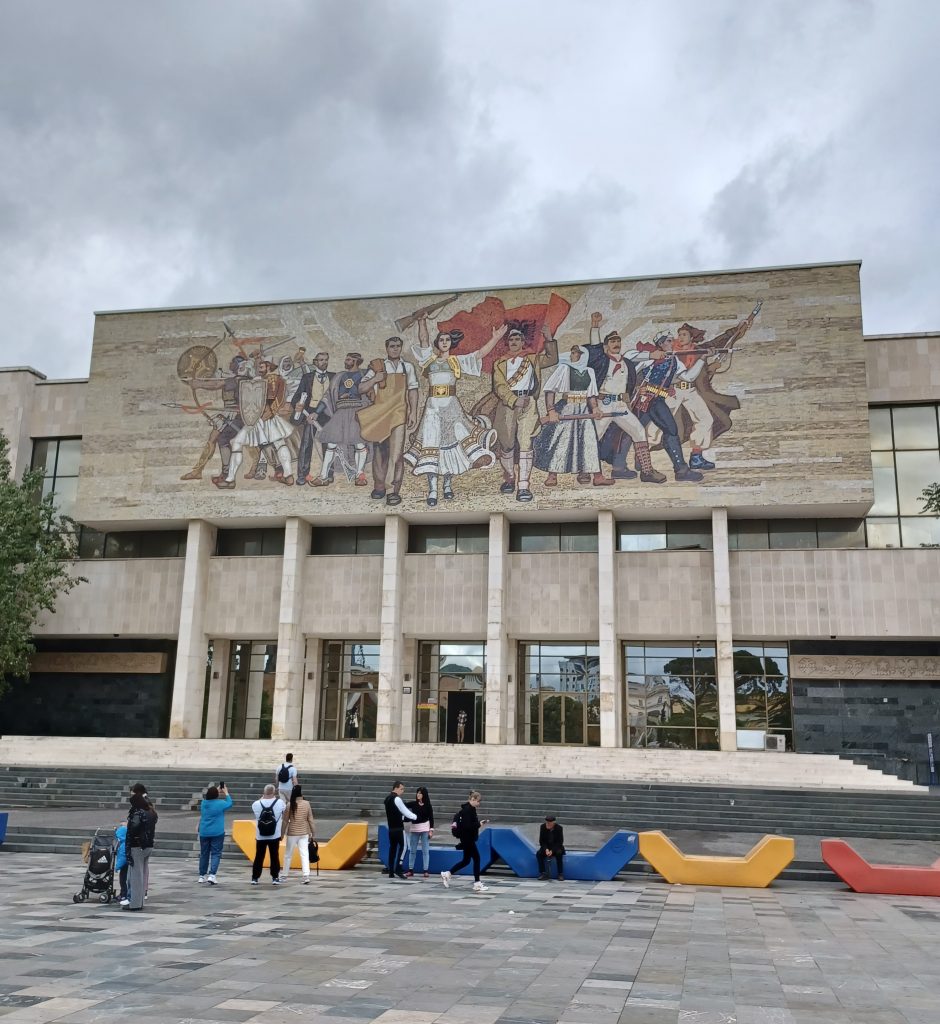
Guided tour over, we take our leave of Tirana. Bit of a hasty visit. Impressive capital city though compared to what it must have been like only 30 years or so ago.

Leave a Reply